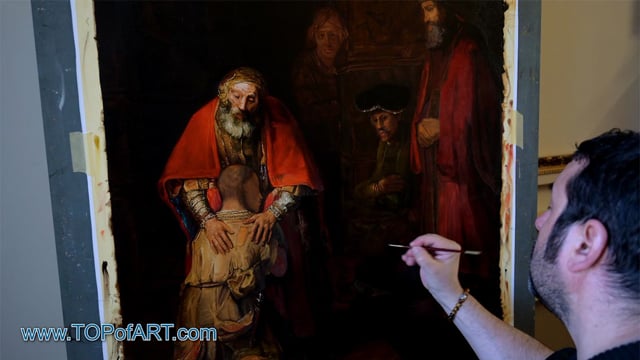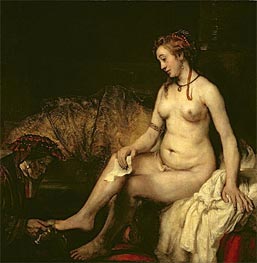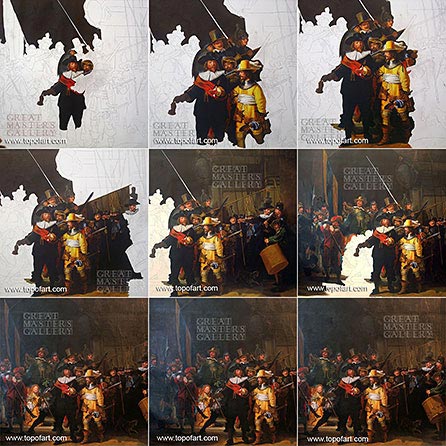The Night Watch, 1642 van Rijn Rembrandt (1606-1669)
Location: Rijksmuseum Amsterdam NetherlandsOriginal Size: 363 x 437 cm


Recreating Rembrandt: A Video Journey into Museum-Quality Reproductions by TOPofART
Video showcasing the process of hand-painting a Rembrandt masterpiece with the utmost precision and care for detail.
Oil Painting Reproduction
If you want a different size than the offered
Description
Painted by European Аrtists with Academic Education
Museum Quality
+ 4 cm (1.6") Margins for Stretching
Creation Time: 8-10 Weeks
Creation Process
We create our paintings with museum quality and covering the highest academic standards. Once we get your order, it will be entirely hand-painted with oil on canvas. All the materials we use are the highest level, being totally artist graded painting materials and linen canvas.
We will add 1.6" (4 cm) additional blank canvas all over the painting for stretching.
High quality and detailing in every inch are time consuming. The reproduction of van Rijn Rembrandt also needs time to dry in order to be completely ready for shipping, as this is crucial to not be damaged during transportation.
Based on the size, level of detail and complexity we need 8-10 weeks to complete the process.
In case the delivery date needs to be extended in time, or we are overloaded with requests, there will be an email sent to you sharing the new timelines of production and delivery.
TOPofART wants to remind you to keep patient, in order to get you the highest quality, being our mission to fulfill your expectations.
We not stretch and frame our oil paintings due to several reasons:
Painting reproduction is a high quality expensive product, which we cannot risk to damage by sending it being stretched.
Also, there are postal restrictions, regarding the size of the shipment.
Additionally, due to the dimensions of the stretched canvas, the shipment price may exceed the price of the product itself.
You can stretch and frame your painting in your local frame-shop.
Delivery
Once the painting The Night Watch is ready and dry, it will be shipped to your delivery address. The canvas will be rolled-up in a secure postal tube.
We offer free shipping as well as paid express transportation services.
After adding your artwork to the shopping cart, you will be able to check the delivery price using the Estimate Shipping and Tax tool.
Museum Quality
The paintings we create are only of museum quality. Our academy graduated artists will never allow a compromise in the quality and detail of the ordered painting. TOPofART do not work, and will never allow ourselves to work with low quality studios from the Far East. We are based in Europe, and quality is our highest priority.
Additional Information
The painting may be more properly titled The Company of Frans Banning Cocq and Willem van Ruytenburch. It is on prominent display in the Rijksmuseum, Amsterdam, the Netherlands, and is its most famous painting.
Key elements
The painting is renowned for three elements: its colossal size (363 x 437 cm or 11ft 10in x 14ft 4in), the effective use of light and shadow, and the perception of motion in what would have been, traditionally, a static military portrait.
This painting was completed in 1642, at the peak of the Netherlands' golden age. It depicts the eponymous company moving out, led by Captain Frans Banning Cocq (dressed in black, with a red sash) and his lieutenant, Willem van Ruytenburch. With effective use of sunlight and shade, Rembrandt leads the eye to the three most important characters among the crowd, the two gentlemen in the centre (from whom the painting gets its original title), and the small girl in the centre left background. Behind them the company's colours are carried by the ensign, Jan Visscher Cornelissen.
The militiamen were also called Arquebusiers, after the arquebus, a sixteenth-century long-barrelled gun.
Rembrandt has displayed the traditional emblem of the Arquebusiers in the painting in a natural way: the girl in yellow dress in the background is carrying the main symbols. She is a kind of mascot herself: the claws of a dead chicken on her belt represent the clauweniers (arquebusiers); the pistol behind the chicken stands for 'clover'; and, she is holding the militia's goblet. The man in front of her is wearing a helmet with an oak leaf, a traditional motif of the Arquebusiers. The dead chicken is also meant to represent a defeated adversary. The colour yellow is often associated with victory.
Alterations to original
For much of its existence, the painting was coated with a dark varnish which gave the incorrect impression that it depicted a night scene, leading to the name by which it is now commonly known. This varnish was removed only in the 1940s.
In 1715, upon its removal from the Kloveniersdoelen to the Amsterdam Town Hall, the painting was cut down on all four sides. This was done, presumably, to fit the painting between two columns, an all too common practice before the 19th century. This resulted in the loss of two characters on the left-hand side of the painting, the top of the arch, the balustrade, and the edge of the step. This balustrade and step were key visual tools used by Rembrandt to give the painting a forward motion. A 17th century copy of the painting by Gerrit Lundens at the National Gallery, London shows how it looked originally.
Acts of vandalism
The work was attacked with a bread knife by an unemployed school teacher, Wilhelmus de Rijk, in 1975, resulting in a large zig-zag of slashes. It was successfully restored but some evidence of the damage is still observable close-up. De Rijk committed suicide in April 1976.
In 1990, a man sprayed acid onto the painting with a concealed pump bottle. Security guards intervened and water was quickly sprayed onto the canvas. Luckily, the acid had only penetrated the varnish layer of the painting and the painting was fully restored.
Painting's commission
The painting is said to have been commissioned by the Captain and 17 members of his Kloveniers (civic militia guards), and although 18 names appear on a shield in the centre right background, the drummer was hired, and so was allowed in the painting for free. A total of 34 characters appear in the painting. Rembrandt was paid 1,600 guilders for the painting (each person paid one hundred), a large sum at the time. This was one of a series of seven similar paintings of the militiamen commissioned during that time under various artists.
The painting was commissioned to be hung in the banquet hall of the newly built Kloveniersdoelen (Musketeers' Meeting Hall) in Amsterdam. Some have suggested that the occasion for Rembrandt's commission and the series of other commissions given to other artists was the visit of the then French Queen Marie de Medici in 1638. Even though she was escaping at the time from her exile from France by her son, Louis XIII, her arrival was met with great pageantry.
Location
It was first hung in the Kloveniersdoelen in Amsterdam in the Groote Zaal (Great Hall). This is now known as the Doelen Hotel. In 1715 it was moved to the Amsterdam town hall, for which it was altered. When Napoleon occupied the Netherlands, the town hall became the Palace on the Dam. The magistrates moved the painting to the Trippenhuis of the family Trip. Napoleon ordered it back, but after the occupation the painting was moved to the Trippenhuis again, which had now become the Rijksmuseum, and was moved to the new Rijksmuseum building when it was finished in 1885. Its last major movement was during the Second World War, when it was kept in a secure bunker under the hills of Limburg for over five years, detached from its frame and rolled around a cylinder. It was restored to the Rijksmuseum after the war.
Popular reception
A persistent misconception has it that Rembrandt's decline in popularity was due to a negative public reception of the painting. The myth has even made its way into modern advertising; in 1967 KLM featured the painting in an advertisement which said "See Night Watch, Rembrandt's spectacular 'failure' (that caused him to be) hooted... down the road to bankruptcy". The myth has no reasonable origin: there is no record of criticism of the painting in Rembrandt's lifetime, and Captain Cocq even had a watercolor made of it for his personal album.
The decline in the artist's popularity was likely due not to reaction to any one painting, but to a broader change in taste. During the 1640s wealthy patrons began to prefer the bright colors and graceful manner that had been initiated by such painters as the Flemish portraitist Anthony van Dyck.

Christ and the Woman Taken in Adultery 1644
$2258
$57.93
van Rijn Rembrandt
Original Size:83.8 x 65.4 cm
National Gallery, London, United Kingdom

Suzanna in the Bath 1647
$1605
$61.46
van Rijn Rembrandt
Original Size:76.6 x 92.7 cm
Gemaldegalerie, Berlin, Germany

Aristotle with a Bust of Homer 1653
$1527
$60.76
van Rijn Rembrandt
Original Size:143.5 x 136.5 cm
Metropolitan Museum of Art, New York, USA

A Woman Bathing in a Stream (Hendrickje Stoffels) 1654
$1283
$56.44
van Rijn Rembrandt
Original Size:61.8 x 47 cm
National Gallery, London, United Kingdom

Bathsheba at Her Bath 1654
$1572
$74.62
van Rijn Rembrandt
Original Size:142 x 142 cm
Louvre Museum, Paris, France
